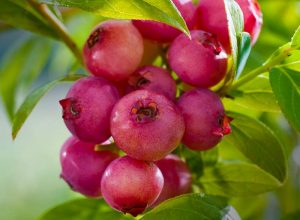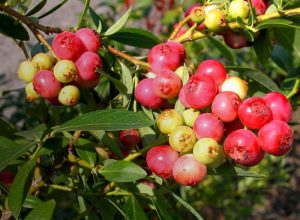Pink Lemonade Blueberry – Vaccinum Corymbosum


The Pink Lemonade Blueberry is a hybrid obtained by American researchers at the end of the last century. We would like to take the opportunity to make the distinction between a scientific hybrid and non.
Scientists obtain their work by genetically modifying- GM. Without wishing to go into too much detail about the dangers involved, and whether research and experiments should continue or be suspended, these are living species where genetic heritage is mutated, eliminated or modified or by adding outside elements. Breeders instead use absolutely natural processes of vegetable fecundation. In fact man behaves like a bee which collects pollen from one flower, species or variety and transfers it to that of another flower, species or variety. The hybrid flower of man is protected by purpose built instruments from before the formation of the flower until the formation of the fruit, so that insects, pollinators or wind do not intervene and modify pollination.
Seeing how successful the the blueberry’s flowers and fruit were, the American breeders tried to select new varieties, and when they proposed to the market the Pink Lemonade Blueberry they couldn’t imagine it would be so notably successful. Obtained by by crossing a cloned derivative from a previous breeding, with another clone with albino fruit, with the Ashei (vaccinium ashei, which is one of the varieties featured in PRANDINI’S GARDEN NURSERY CENTRE CATALOGUE.
Blueberry of which we can retrace its characteristics.
Modest shrub which is unlikely to surpass one and a half metres in height with diverse trunks which start at the base, it has deciduous dark shiny green leaves of medium size and which in Autumn take on apleasant colours, first yellow then red /orange. It loves the sun, but not that of the hottest part of the day and a difference to the other blueberries it doesn’t support intense cold, it stands to sub zero, for planting you have to find a somewhat sheltered spot and remember to cover the base of the plant with a spread of leaves. It can grow very well in pots and so in regions where winters are hard It is possible to move them to more sheltered areas.
TERRAIN
As with all the BLUEBERRIES, Vaccinium myrtillus, even the pink lemonade blueberry requires a distinctly acid soil, in that neutral o basici, con ph 7 and above, will raise the ferric chlorosis which could kill the plant in a few months.. They should be in fresh organic soil, rich in humus, well drained and without stagnant water.
FLORA AND FRUIT
A lovely bush which IN Spring produces an abundance of flowers made up of 4/8 small creamy white flowers, bell shaped, typical of the Ericaceae family, with a delicate fragrance of honey. The flowers are self-pollinating, but for a better production it is always opportune to plant two or more plants together to facilitate cross pollination. At the beginning of Summer bunches of 4 /10 small fruit appear, first white then pale pink and finally a very showy fuchsia, which covers the bush in a very effective pleasant way.
Not having that sour taste which distinguishes in general all the Blueberries, the fruit of the Pink Blueberry are very sweet and so are very appetizing to birds and wild animals, with the approaching maturing it would be very opportune to shield the plant with an anti bird net. accepted immediately in the pastry laboratories as an esthetic complement and as an ingredient. it would be opportune to shield the shrub with an anti bird net.
USE AND HEALTH GIVING PROPERTIES
The fruit of the pink blueberry is very flashy and good and so it has been immediately accepted by pastry shops as an esthetic compliment and also as an ingredient.
For its characteristic colour it is much used blended and in fruit salads and tarts and anything else you can put your mind to.
We are not aware of any specific health properties of the pink blueberry, we can suppose it to have the same health characteristics as the blueberry, even if certain main actives, like flavonoidi, potent antioxidants, which are usually present in fruit with a blue skin.
POTTING PRUNING AND CULTIVATION
Is the same for all the varieties of mirtillo then we reiterate as described before: It is very important that the soil is suitable to the plants needs. After this premise even the description of care of the plant is easy because you have a vigorous and strong plant that needs little intervention. The first one or two years after planting you will need to work on the roots well, while the aerial system will give the impression of suffering. Following this period, production will be modest as also the potting which you should concrete by cutting the low side branches and removing the weak branches.
You should then proceed with thinning out the weak vegetation starting at the base and cutting the ruined or rotting branches, with what remains you should return cut until the side smaller branches are more vigorous. You should also cut back those branches which although healthy are untidy.
Having a very superficial root system, watering is very important especially during the periods of blooming and fruit picking. Be careful of stagnant water which can lead to the formation of fungus that could rot the roots.
To maintain humidity, and at the same time keep the soil clean and acid, a mulch of acid torba or pine needles or beech tree leaves is advisable.
Winter in the months of November to January and the Following these guidelines fertilization shouldn’t be necessary but if you notice any deficiency in the plant at the beginning of the season, a ternary fertilizer low in azoto and containing microelements should be effective.
Never use manure even if very mature as the plant will suffer from ferric chlorsis and consequently die.
Parasite attacks are few and far between the most dangerous is the oziorinco, a small beetle which as an adult will gnaw the leaves and deposit its eggs on the ground; the derivative lava will eat the roots and worse will erode the collar of the plant causing it to die.
In specific atmospheric conditions, grey mould (Botrytis) attacks are possible on the next fruit to mature, but not being able to treat with pesticides the only solution is to manually remove the stricken fruit. Remember that PRANDINI’S GARDEN NURSERY CENTRE, is available to collaborate and advise on the density of the implant, form of rearing, crop choice and assistance, even with plant health for new productive implants even of modest dimensions.
